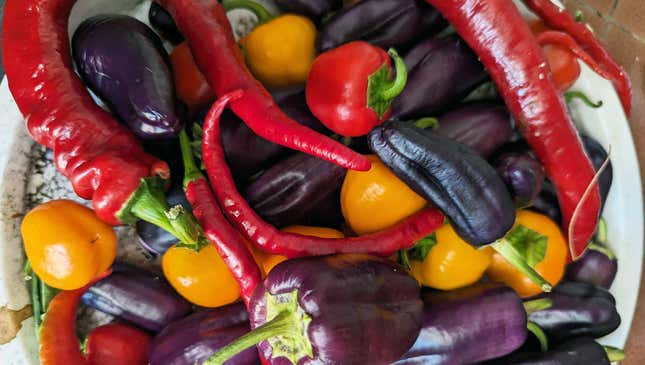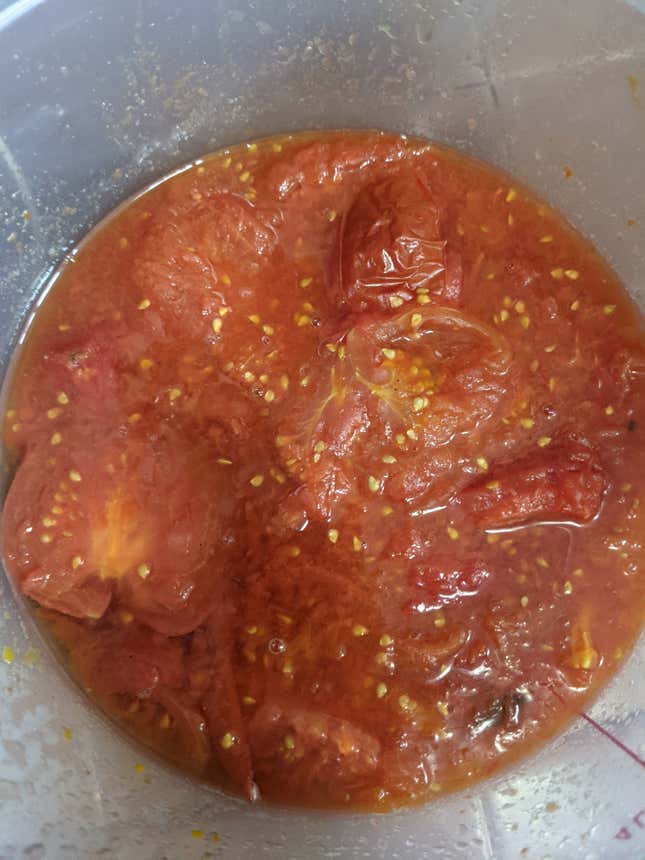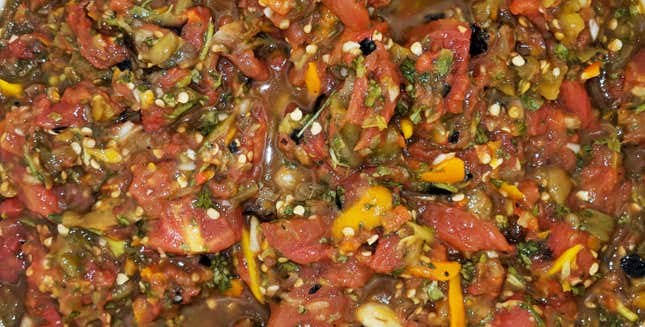Straight talk: You need to ferment your salsa. I could explain, over a lot of words, how it intensifies the tomatoes, and how the fermented peppers add a depth of umami that balances the salt and acid, and how it transforms all of the individual components of salsa into a unified flavor bomb that you just want to eat with a spoon. I could do all that, but really, you just need to taste it once in order to become a believer. Good news, it requires almost no talent to do so.
Now is the time to try it, for a few reasons. It’s high tomato season, and while you can get a tomato at the store any time of year, reasonable people all agree that a ripe summer tomato is nothing like that pale, round thing you get at the grocer in the middle of winter. Your house is also likely the perfect temperature for fermentation right now (60-80℉). Lastly, it’s prime pepper time. Your garden, farmers market, and even grocer likely has fresh peppers in varieties you don’t normally see. I am greeted by bags of Hatch peppers each time I visit the store this time of year.

Choose your heat wisely
Table of Contents
It all starts with peppers, the defining component of your finished salsa. Peppers can bring heat, they can bring flavor, and they can bring heft, all depending on which ones you choose. For our recipe, we’re going to start with three pounds of peppers, which sounds like so much, but once you roast them, peel them and take out the seeds, you’ll find their mass is reduced by more than half.
At least half of those peppers should be something mild, like bell peppers or other sweet peppers like banana or Italian. I know that sounds boring, but there’s a lot of sweet meat on those ribs. I like red, yellow, orange and purple peppers, and by that I mean, don’t get green bell peppers. You can do large or small bell peppers, ultimately it won’t matter.
For the other one and a half pounds, you can choose your level of heat, but I caution you to go easy. A single ghost pepper will have a profound effect on your salsa, and too many of them will render it inedible and are kind of one-note, taste-wise. If you are a glutton for punishment, consider a jalapeño, a hot Thai pepper, and maybe a serrano or habanero, but only one of each. The rest of the mix can be mid-range heat peppers like poblano.
Use peppers as your fermentation starter
In any case, you’re going to take your peppers, cut them in half, and lay them on a cookie sheet and put them under the broiler. You can grill them instead, or char them in any manner you choose. As the skins blister and turn black, throw them into a brown paper bag and fold over the top. Leave them in there for 10 minutes, and let the steam inside separate the skin from the flesh. Now pull off the stems and seeds, removing any skin that comes off easily. Leaving behind some char is not only ok, but ideal.

Layer those peppers into a half-gallon glass jar fitted with a fermentation lid. Fill the jar to the top with a 2% brine, making sure all the peppers are submerged. You can make enough brine for this by boiling four cups of water with 20 grams of salt. Once it’s cooled, pour it into the jar. Now place the jar someplace with an ambient temperature of 60-80℉, away from the light, for two or three days. Once you see the jar bubbling, it’s actively fermenting. From then, give it one more day. This is what you’ll use to ferment the other ingredients in your salsa recipe.
Roast your tomatoes

This time of year, you can use almost any kind of tomato in your salsa. While normally you’d use sauce tomatoes like Roma for this, if you have access to great looking slicer tomatoes, you can use those as well for even more flavor, or mix it up, using some of each. Not only will it taste better, but the mix of colors will improve how the salsa looks.
You don’t actually have to peel tomatoes to make salsa, but roasting them makes it easy work. Slice the tomatoes in half, lay them on a rimmed cookie sheet and place them in an oven set to 400℉, on the top rack. Depending on the size of the tomatoes, it should take 15-25 minutes for the tops to blister and become dark brown. At that point, remove the cookie sheet, and pluck the skins off with a pair of tongs. The remaining tomatoes can go into a bowl with the tomato juice from the pan, until they cool. You can choose to not roast your tomatoes, and just use them raw, with the skins on, but roasting adds another layer of flavor I really appreciate.
Use every part of the cilantro
If you don’t like cilantro, and don’t have that gene that makes it taste like soap, then I question your commitment to salsa. For the rest of us, I encourage you to consider the entire plant, stems and all, excluding only the very end. The stems provide a bite that I think you’ll find very pleasant.
Now it’s time for secondary fermentation

Once you’ve fermented your peppers and gathered the rest of your ingredients, which includes garlic and onions in addition to tomatoes and cilantro, you’re going to chop the tomatoes and peppers and add everything to a food grade bucket with a fermentation lock. The peppers are an active ferment, and will act as a fermenter for the salsa itself.
Add the additional salt, and mix everything together well. The bucket should stay in a room that is between 60-80℉, and you should check it daily, with a clean spoon. Even on day one, the flavor will be deeper than “normal” salsa. It gets a little funkier and deeper with each day, but it should all be eaten or refrigerated by day three or four. Over fermented salsa gets very fizzy, but the fridge will stop the fermentation. Still, it should be eaten within the week, which is never a problem.
Fermented salsa
Ingredients (makes a gallon of salsa):
- 3 pounds peppers of your choosing
- 2 large sweet onions
- 3 bunches of scallions
- 2 bunches of cilantro
- 6 pounds of tomatoes
- 1 large head of garlic or two smaller heads
- 40 grams of canning salt
- 4 cups of water
Halve and roast the peppers under your broiler, on the grill or over an open flame. Once they’re charred and blistered, place them in a paper bag for 10 minutes to steam, then remove as much skin, stem, and seeds as you can. If you’re using hot peppers, be careful to wear gloves when handling them.
Make a 2% brine by boiling 4 cups of water and 20 grams of salt, and allow to cool completely. Place the peppers in a half-gallon glass jar with a fermentation lock and cover with the brine. Allow the peppers to ferment for 2-4 days, until you see bubbling when you open the jar. Then wait one more day before proceeding with the rest of the recipe.
Optional: Roast the peppers by halving them and roasting in the oven, on rimmed cookie sheets, at 400℉ for 15-20 minutes, until brown and blistered. Remove the skins and then pour off the tomatoes and liquid so it can cool. If you prefer to use raw tomatoes instead, skip this step.
Dice the onions, chop the cilantro—including the stems except for the last little bit—and finely dice the garlic.
Chop the tomatoes and the peppers into ½-inch sized pieces.
Place all the ingredients, including the brine and tomato liquid from roasting into a food grade bucket with a fermentation lock. Add the rest of the salt, and mix everything together. Leave the bucket in a cool dark place with a temperature somewhere in between 60-80℉.
Check the taste of the salsa daily with a clean spoon. When you’re satisfied with the flavor, eat the salsa and move the rest to the fridge, which will stop the fermentation.
